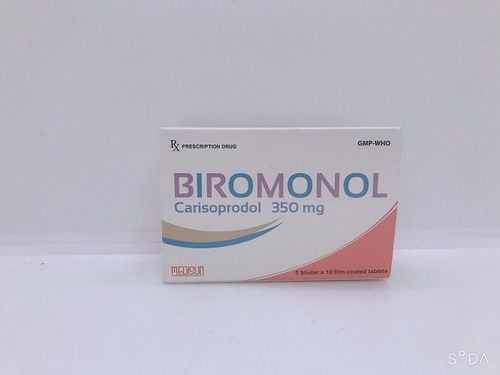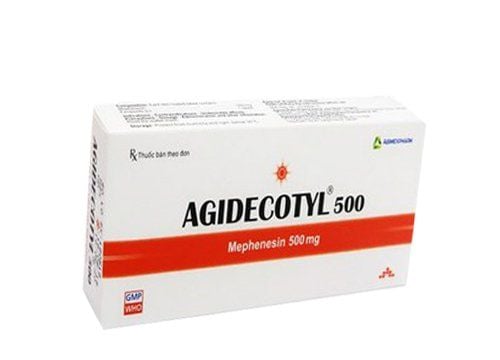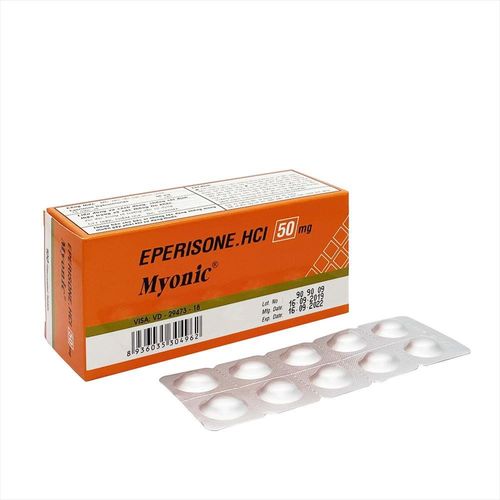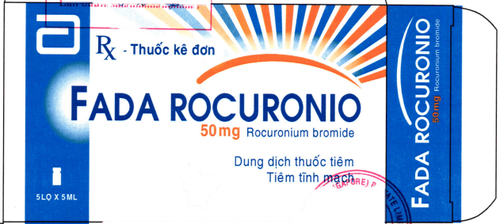This is an automatically translated article.
Stretching after exercise is extremely important to help you recover and reduce post-exercise pain. But many of you overlook and often ignore these stretching exercises. Immediately refer to the complete instructions on stretching exercises from basic to advanced below to apply practice.
1. Foot and Ankle Stretching Exercises
For stretching movements, you need to pay special attention to the leg muscles because this is a part of the body that is often active, subject to a lot of pressure and has to bear most of the movement in the body. Stretching exercises for the feet, ankles and shins, including the calves (stomach and muscles), sternocleidomastoid, calves. These stretches are important for recovering from a leg injury.
1.1. Ankle extension * Leg stretch
This exercise stretches the muscles in the front of the lower leg including the anterior tibialis, lateral sternocleidomastoid muscles
Kneel on the floor with both knees, with shins flat on the ground and toes/feet facing back. Slowly sit back on your heels. If you can't feel the stretch, put your hands on the floor behind you and lean back. Additional stretch can be added by placing a rolled towel under the top of the shin to increase the angle of extension at the ankle. * Standing shin
A shin stretch is often overlooked until an injury, such as a shin splint, occurs. This is an excellent treatment and prevention for stretch marks.
Stand with the toes of your left foot on the floor on the outside of your right foot. Bend right leg to push ankle toward the ground. Hold for 10 to 30 seconds. Switch legs * Advanced shin stretch
This stretch should only be done by people who do not feel a stretch in the shin and straighten the shin.
Kneel with your legs straight on the ground. Place your hands on the floor next to your knees. Lift your knees off the floor, keeping your heels and knees together and feet on the floor. Hold for 10 to 30 seconds. 1.2. Ankle stretch for calf muscles * Calf stretch on one step
This stretch is really effective but you have to be careful and make sure you have something to hold on to!
Stand on the floor in front of a small step or a thick book. Raise toes to stay on step, keeping heels on floor and knees straight. Shift your body weight forward until you can feel a stretch in your calf muscles. To stretch the lower leg muscles, bend the knee slightly. * Standing calf stretch
Calf stretch can help prevent a whole range of lower extremity injuries.
Stand with one foot far in front of the other and lean against a wall. Keep the back heel flat on the floor. Bend the front leg to lean forward and keep the back leg straight. Hold the position for 10 to 30 seconds. * Stretching
Knee flexion dilates the stomach, allowing the lower leg muscles to be stretched separately.
Stand with one foot in front of the other, close to the wall. Place your hands on the wall for balance. Bend both knees, focusing on the back knee. Move your weight forward onto your toes but make sure you keep your heels behind. Hold for 10 to 30 seconds * Raised sole stretch
Stand with toes on one step, heels back and knees bent. Make sure you have something to hold onto before carefully lowering your heels until you can feel the stretch. Hold the position for 10 to 30 seconds. 1.3. Ankle Stretches for the Perineal Muscles The abdominal muscles run along the outside of the legs and are difficult to stretch and are often overlooked in a stretching routine.
Sit in a chair with one ankle resting on the other knee. Use your hands to point the foot and rotate the sole of the foot upward (reverse). Hold the position for 10 to 30 seconds. 1.4. Plantar fasciitis Stretching the plantar fascia that runs below the arch of the foot can be a useful part of the treatment of plantar fasciitis.
Sit on the floor with your knees bent and heels on the floor. Pull the toes up to stretch the arch of the foot. Hold the position for 10 to 30 seconds.
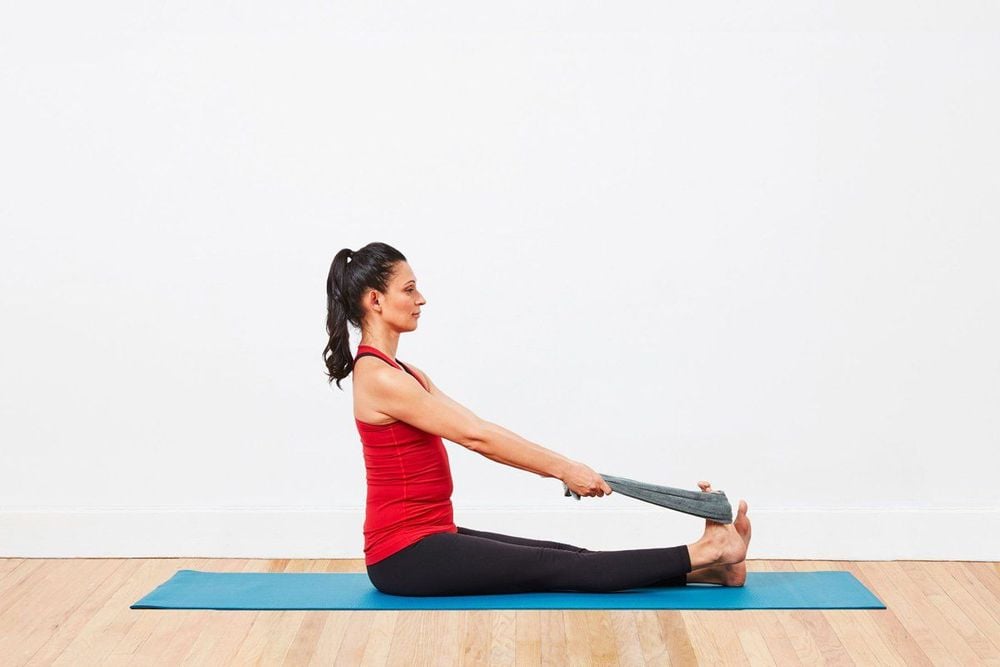
Những động tác kéo giãn cơ chân rất quan trọng để phục hồi sau chấn thương ở cẳng chân.
2. Thigh stretching exercise
Quadriceps and hamstring stretching exercises are important for preventing and recovering from hamstring strains, thigh contractions, quadriceps strains, and groin injuries.
2.1. These stretch exercises are some of the most commonly recognized and used stretching exercises and are especially important for recovering from quadriceps and hamstring strains.
* Standing quadriceps stretch
Stand on one leg and pull the other leg up behind your buttocks. Keep your knees close together and push your hips forward to increase the stretch.
Pushing the hips forward increases tension in the larger rectus femoris that crosses both the hip and knee joints (known as biaxial muscles). Hold the pose for 10 to 30 seconds. You should feel a gentle pull on the front of the thigh but no pain. * Kneeling quadriceps stretch
This pose helps stretch the Rectus Femoris muscle even longer on the sternocleidomastoid muscle. However, don't do this move if you have any kind of knee injury, as the knee is quite stiff.
Place one knee on the floor and the other foot in front, knee bent and foot on the floor. Grasp the ankle of the back leg toward the back of you. Lean forward from your hips and at the same time pull your ankles toward your butt. When you can start to feel a stretch in your front thighs, hold the pose. Hold the pose for 20-30 seconds and repeat at least twice. 2.2. Hamstrings These exercises stretch the hamstring muscles on the back of the thigh. The hamstring muscle group includes the Biceps, Semitendinosus, and Semimembranosus muscles. Hamstring stretches can be isometric (static exercises for the hamstrings), dynamic, or somatic neuromuscular (PNF) stretches.
Isometric tension is where holding a position is stretched with no movement other than increasing the required stretch. Stretching is done with a relaxing swinging motion and is more functional or athletic in nature. PNF stretches involve alternating contraction of the muscle with its release and stretching.
* Standing hamstring stretch
This is a convenient stretch if the ground is cold or wet.
Stand with one foot directly in front of the other. Bend the back knee and place your weight on the bent knee. Tilt your hips forward as if you were raising your butt to the sky. Hold this position for 10 to 30 seconds. * Sitting Tendon
This is probably one of the most commonly performed hamstring stretches. The benefit of sitting stretches is that the athlete can completely relax while stretching.
Sit on the floor with both legs straight. Keep your back straight as you lean forward over your hips. Hold the pose for 10 to 30 seconds. * Get someone to help you stretch the hamstrings
The hamstrings are probably the muscles most often strained and this can contribute to lower back pain.
Lay up. Lift one leg off the floor, keeping the knee straight. Ask your helper to push higher until you feel a stretch. Hold the pose for 10 to 30 seconds. 2.3. The following dynamic hamstring stretches are especially important in the later stages of a hamstring stretch rehab program.
The thigh stretch consists of gently swinging the leg back to the straightened position. Make sure your legs are always relaxed and not strained. Do 3 x 10 times gently swinging the straight leg as high as possible. It can be helpful to target the other hand on the swinging leg and possibly trick the brain into thinking that swinging the leg is safe.
* Active straight leg lift
Start active straight leg lift from lying on the floor. The practitioner raises the injured leg as high as it is painless, then lowers it again. Do 3 sets of 10 times once or twice a day. Try to be more flexible with this exercise and aim to gradually straighten the knee as flexibility allows.
* Cycle upside down
Exercise lying on the floor. The practitioner lies on his back and uses his hands to support his hips while performing the pedaling movement with his legs.
* Dynamic walking
They can start with the athlete walking forward while kicking the leg straight up in front of each step to get dynamic stretch.
Leg rotation should be controlled and not forced, always within a pain-free range of motion. Do 3 sets of 10 repetitions per day. This exercise should be done for at least 2 days if no pain is felt. The practitioner has completed all of the phase hamstring stretches, when this and others have been performed before, painlessly with equal flexibility in both legs.
3. Hip and groin stretching exercises
These exercises are important for recovery from groin strains, piriformis syndrome, and other hip and groin related injuries.
3.1. External hip stretch These exercises stretch the muscles mainly on the outside of the hip and include the glutes and sternocleidomastoid flexors
* Maximal gluteal stretch
Buttock lift can be great for relieving symptoms caused by sciatica.
Lie on your back on the floor. Pull your bent knee up toward the opposite shoulder. Hold the pose for 10 to 30 seconds. * Tensor fascia latae
Stand with one leg extended behind the other. Lean to the side without stretching. Push the hip you want to stretch to the other side. Hold the pose for 10 to 30 seconds, rest and repeat 2-3 times. Movements: Perform a forward lean, using a wall or table for support. Bring the stretched leg as far away from the body as possible.
To stretch the thigh fascia in a seated position, the athlete pulls the knee across and toward the body.
* External hip stretch
Stretching the muscles of the outer hip such as the tensor fascia latae and also the Iliotionate band can be effective in treating runner's knee. This stretch also targets the glutes and glutes.
Lie on your back on the floor. Cross your right leg over your left knee, keeping your right knee bent. Use your left hand to pull your right knee across your body. Hold the position for 10 to 30 seconds. *Piriformis strain
The piriformis muscle can be very annoying and cause symptoms of sciatica including pain that radiates down the leg. Stretching this muscle will keep it supple and prevent it from affecting the sciatic nerve.
Lie on your back, cross your right ankle over your left knee. Grasp the thigh of the left leg and pull the knee toward you, lifting the leg off the floor
Pull the knee toward you to increase the stretch.
Hold the pose for 10 to 30 seconds
3.2. Groin * Additive Stretch
Stretching the adductor muscles will help keep your hip flexible, which is important in preventing injury.
Sit on the floor with your feet as far apart as possible and knees straight. Keep your back straight and lean forward from your hips. Hold the pose for 10 to 30 seconds. *Stand up hip stretch
This easy stretch can help prevent and treat groin strain injuries. This stretch targets gracilis, adductor magnus, adductor brevis and adductor longus.
Stand with feet wide and knees straight. Bend your right knee to the side and lean to the right. Hold the pose for 10 to 30 seconds. 3.3. Hips * Hip Stretch
This is an effective stretch commonly used for the muscles in the front of the hip including the mid thigh (Rectus Femoris).
Kneel with one knee on the floor and the other foot in front with the knee bent. Push your hips forward and keep your back upright. Hold the pose for 10 to 30 seconds. * Hip flexion
Stretching stretches your muscle while it's moving. This type of stretch should be part of any warm-up before a workout. Forward and backward stretch the hip flexors, and horizontally stretch the groin and abdominal muscles.
Gently swing your legs comfortably. It should not be forced. Squeezing is a ballistic stretch that can cause muscle damage. Aim for 10 swings on each leg, 3 repetitions per day.
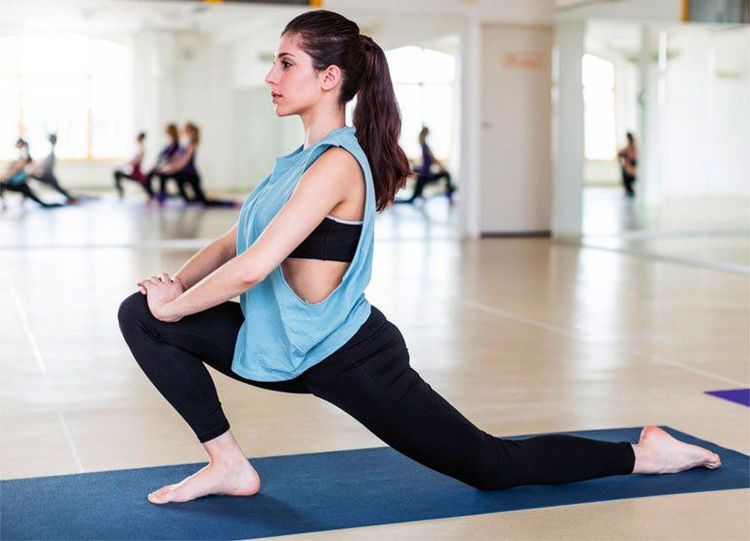
Các bài tập kéo giãn hông và háng rất tốt cho việc phục hồi sau các chấn thương
4. Back stretching exercise
Back stretching is important to include in your overall exercise routine to help prevent injury and even improve athletic performance. If you suffer from back pain or any type of back injury it is important to get professional advice as some back exercises may not be suitable.
* Lower lumbar rotation
This exercise aims to increase the flexibility of the lumbar muscles.
Leg weight provides stretch, but it can be increased using your hands.
Lie on your back, straighten both legs. Bring one knee up toward your chest. Then bring through your body, trying to get your inner knee to touch the floor on the other side of your body. Hands can be used to increase rotation if necessary. * Lower back stretch
Stretching the muscles in the lower back can help people with back pain greatly reduce pain. This lower back exercise targets the erect spine.
Lie on your back on the floor. Bring your knees in front of your chest and use your arms to pull them in deeper. Hold the pose for 10 to 30 seconds. Moves: Do one leg at a time or add a twist to stretch the glutes even more.
* Large back muscles (Latissimus dorsi)
The muscles of latissimus dorsi are often not warmed up routines. However, all it takes is a simple stretching exercise or kneeling on the floor.
Stand up straight with your arms above your head. Raise your hand as high as possible. Hold the pose for 10 to 30 seconds. The alternative is to hold onto a bar or vertical post and lean back.
* Side Stretch
The classic side stretch works all the muscles on one side of the body, from the arms down to the hips.
The muscles that are stretched are the quadriceps (quadratus lumborum), the internal and external obliques.
Stand up and reach above your head with one arm. Lean to the opposite side.
Hold the pose for 10 to 30 seconds. Switch sides.
5. Shoulder stretching exercise
Shoulder stretching exercises, including anterior shoulder stretch, chest stretch, triceps stretch, and major back stretch as well as partner-supported exercises can further increase range of motion in the joints shoulder.
* Anterior Shoulder Stretch
Stretching the anterior shoulder and pectoral muscles can help improve posture. There are several ways to stretch the muscle in the front of the shoulder. Stand up straight. Clasp your hands behind your back. Slowly lift your hands away from your back and toward the ceiling. Hold for 10 to 30 seconds. Variation: Place your palms on your lower back. Try to bring your elbows together behind your back.
* Chest stretch
Stretching the chest muscles, especially the small part of the chest, can be beneficial in improving the posture of the upper back and shoulders.
Stand in the doorway or by the wall. Bend the extended arm and place the forearm straight against the wall or door frame. Step forward and rotate your body away from outstretched arms. Hold the pose for 10 to 30 seconds. * Triceps Tension
The muscles of the arm including the triceps are often overlooked when performing a stretch routine. Stretching the triceps especially after weight training can help reduce late-onset muscle soreness (DOMS).
Place your hands on your upper back with elbows bent toward the ceiling. Use your other hand to pull your elbow toward your head. Hold the pose for 10 to 30 seconds. Variation: Hold the towel in the hand of the outstretched arm and bring it into the upper position so that the towel hangs behind your back. Reach your other hand behind your back and pull the towel down.
* Posterior shoulder stretch
Posterior shoulder stretch can be effective in rotator cuff injuries and also when the muscles of the upper back and neck are strained.
Stand up straight and cross one hand over your body. Using the opposite arm, pull the elbow of the extended arm toward the opposite shoulder. Hold the pose for 10 to 30 seconds. * Assisted external rotator cuff stretch
Lie on your back, flex your shoulders to 90 degrees and bend your elbows to 90 degrees. Ask an outside helper to rotate your shoulders, i.e. push your fist back toward the floor. Make sure they support the upper arm at the elbow. Hold for 10 to 30 seconds.
Movements:
If you don't have a partner to help, stand with your back against the wall. With the arm in the original position try to touch the fist against the wall. As this move gets easier, move forward slightly to allow for more movement.

Các bài tập kéo giãn vai bao gồm: căng vai trước, căng ngực, căng cơ ba đầu và căng cơ lưng lớn
6. Elbow and Wrist Stretching Exercises
Elbow and arm stretching exercises are often the most important when recovering from an elbow or wrist injury, and include wrist flexion exercises, wrist stretchers, tennis elbow stretches, and muscle exercises. three heads. In particular, boxers often perform wrist and arm stretches as part of the warm-up process.
* Wrist flexor stretch
Wrist flexor stretch can be difficult, but using a wall to apply pressure and increase range of motion can be very effective. Make sure you keep your elbows straight.
This stretch targets the flexor carpi radialis, flexor carpi ulnaris, flexor digitorum, and biceps.
Stand facing the wall, arms outstretched and palms up. Place your fingers on the wall facing down. Slowly try to place your entire hand flat on the wall by extending your wrist. Hold for 10 to 30 seconds. Movements
Perform on all fours so that the fingers point towards the knees. To increase the stretch, sit with your back against your heels. * Wrist Stretches
Wrist stretches can be an effective treatment for elbow arthritis. This extension targets the carpi radialis brevis extender, the carpi radialis longus extender, the carpi ulnaris extender, and the digitorum communis extender.
Keep one arm straight in front. Use your other hand to bend your wrist and point your fingers toward the floor, applying gentle pressure. Hold for 10 to 30 seconds. * Arm triceps stretch
The muscles of the arm including the triceps are often overlooked when performing a stretch routine.
Stretching triceps especially after weight training can help reduce DOMS. This stretch targets the biceps triceps. Place your hands on your upper back with elbows bent toward the ceiling. Use your other hand to pull your elbow toward your head. Hold for 10 to 30 seconds. * Wrist stretch
This exercise aims to increase range of motion into side and back lying. Tilt is the movement of turning the hand so that the palm is facing down. Supination is the opposite movement so that the palm is facing up.
To increase range of motion into supine and side lying - i.e. rotating palm up or down, a weighted bar can be used to support gravity.
The practitioner sits with the elbows supported, just below the shoulders. The end of the bar is held with one hand, positioned at the end range for either movement. This process must be kept for at least 5 minutes.
7. Neck stretching exercises
Neck stretching exercises include rotational stretches, forward and lateral flexion stretches, and the Sternocleidomastoid neck stretch. Neck exercises are also great for reducing stress caused by sitting too many hours in front of a desk or computer.
* Rotation
Stretching your neck from side to side can help relieve neck pain, especially if you use gentle pressure with your hands. Rotator cuff stretches target the superior fibers of the trapezius, sternocleidomastoid, and scanius.
Start facing straight ahead and with your arms in front of you. Keep your elbows straight and interlock your hands to prevent your shoulders from lifting. Rotate your neck so that your chin is facing your shoulder. Hold for 10 to 30 seconds. * Bend
Doing this stretch regularly can help relieve muscle soreness in the neck and upper back. This stretch targets the superior fibers of the trapezius, splenic duct, and fibula.
Start facing straight ahead and with your arms in front of you. Keep your elbows straight and interlock your hands to prevent your shoulders from lifting. Bring your chin down to touch your chest. Hold for 10 to 30 seconds. * Lateral neck lift
Lateral neck flexor stretch targets the superior trapezius, scapula, and fibula. This stretch can be very helpful for people with tight, sore muscles in the upper back and neck, such as those who work on computers.
Look straight ahead and do not let your chin drop. Move your ears toward your shoulders. Don't let your shoulders lift. Hold for 10 to 30 seconds. Movements:
While doing the right stretch, continue to stretch using your left hand to apply gentle pressure on the right side of the head. * Sternocleidomastoid Neck Stretch
The sternocleidomastoid stretch stretches two long strap-shaped muscles on either side of the front of the neck.
Turn your head to the side as far as it is comfortable Then tilt your head to the same side, as if trying to bring your ear to your shoulder. Hold for 20 seconds, rest and stretch the other side.
Please dial HOTLINE for more information or register for an appointment HERE. Download MyVinmec app to make appointments faster and to manage your bookings easily.






